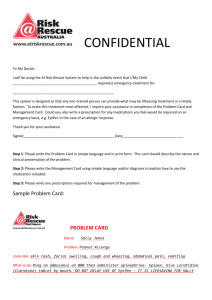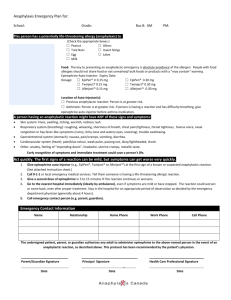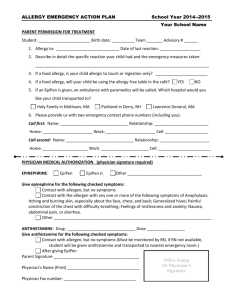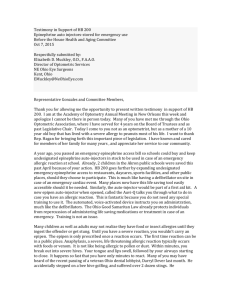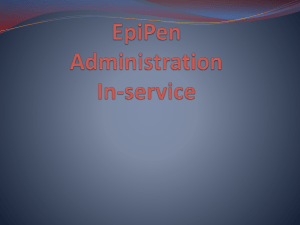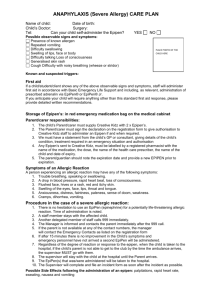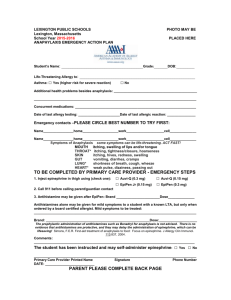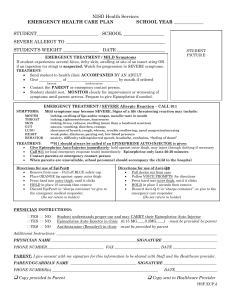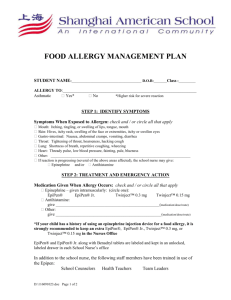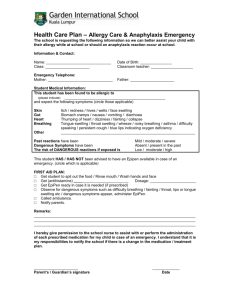Epi-pen Fact Sheet
advertisement
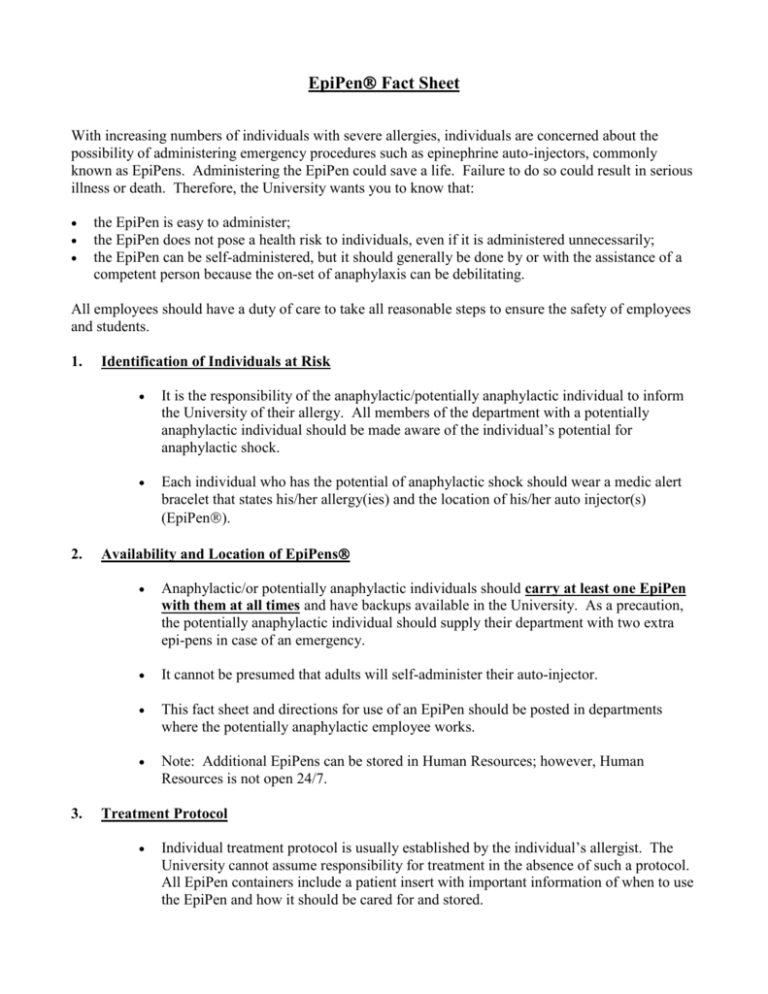
EpiPen Fact Sheet With increasing numbers of individuals with severe allergies, individuals are concerned about the possibility of administering emergency procedures such as epinephrine auto-injectors, commonly known as EpiPens. Administering the EpiPen could save a life. Failure to do so could result in serious illness or death. Therefore, the University wants you to know that: the EpiPen is easy to administer; the EpiPen does not pose a health risk to individuals, even if it is administered unnecessarily; the EpiPen can be self-administered, but it should generally be done by or with the assistance of a competent person because the on-set of anaphylaxis can be debilitating. All employees should have a duty of care to take all reasonable steps to ensure the safety of employees and students. 1. 2. 3. Identification of Individuals at Risk It is the responsibility of the anaphylactic/potentially anaphylactic individual to inform the University of their allergy. All members of the department with a potentially anaphylactic individual should be made aware of the individual’s potential for anaphylactic shock. Each individual who has the potential of anaphylactic shock should wear a medic alert bracelet that states his/her allergy(ies) and the location of his/her auto injector(s) (EpiPen). Availability and Location of EpiPens Anaphylactic/or potentially anaphylactic individuals should carry at least one EpiPen with them at all times and have backups available in the University. As a precaution, the potentially anaphylactic individual should supply their department with two extra epi-pens in case of an emergency. It cannot be presumed that adults will self-administer their auto-injector. This fact sheet and directions for use of an EpiPen should be posted in departments where the potentially anaphylactic employee works. Note: Additional EpiPens can be stored in Human Resources; however, Human Resources is not open 24/7. Treatment Protocol Individual treatment protocol is usually established by the individual’s allergist. The University cannot assume responsibility for treatment in the absence of such a protocol. All EpiPen containers include a patient insert with important information of when to use the EpiPen and how it should be cared for and stored. Please note: EpiPens can be stored in areas where the temperature is up to 25 degrees Centigrade (77 degrees Fahrenheit). Do not store EpiPens in refrigerators. Do not expose EpiPens to extreme cold or heat. All auto-injector EpiPens have an expiration date – for example: December 05 = December 31, 2005 All EpiPens need to be replaced before the expiration date. Examine contents of the EpiPen occasionally through the clear window to ensure that the solution is not discoloured or contains solid particles (precipitate). The solution should be clear and if it is not, the potentially anaphylactic individual should replace the unit immediately. To manage an emergency, please do the following: a. b. c. d. Call 911. One person stay with the injured individual at all times. One person goes for help. Administer epinephrine at the first sign of reaction, however slight (e.g. itching or swelling of the lips/mouth in food allergic individuals). There are no contraindications to the use of epinephrine for a potentially life-threatening allergic reaction. Note time of administration. e. Regardless of the degree of reaction or exposure to epinephrine, transfer the individual to an emergency room asap. Symptoms may reoccur up to eight hours after exposure to the allergen. f. Contact the individual’s emergency contact. 4. Training Each year, the Education Health Centre or a medical professional should provide an awareness session for all staff, which includes a demonstration on the use of the epi-pen. All EpiPen cases have a patient insert that gives information on how to administer an epi-pen. On the web, http://www.epipen.com/howtouse.aspx demonstrates how to use an EpiPen. The directions for the use of an EpiPen should be posted next to this fact sheet. Remember: if the directions for use are missing, each EpiPen tube/case has the directions for use inside of the tube. Administration of Epinephrine Check the EpiPen to ensure the medication has not expired, has not become discoloured, does not contain particulates, or sediments. Prep skin site with alcohol (only if alcohol is available – not necessary). Remove the safety cap from the auto-injector. Place the tip of the auto-injector against the lateral aspect of the patient’s thigh midway between the waist and knee. Push the injector firmly against the thigh until the spring-loaded needle is deployed and the medication is injected (at least 10 seconds). Dispose of the auto-injector in a bio-hazard contained designed for sharp objects as soon as possible. Be careful not to prick yourself as the needle will now be protruding from the end of the injector. Record that epinephrine was administered, the dose, and the time of administration. Side Effects The individual may complain of side effects following the administration of epinephrine. Possible side effects include increased heart rate, pale skin (pallor), dizziness, chest pain, headache, nausea, vomiting, excitability and anxiousness. Call 911 as soon as possible. Anaphylaxis Symptoms and Signs Symptoms may include the following: Difficulty breathing Wheezing Abnormal (high-pitched) breathing sounds Confusion Slurred speech Rapid or weak pulse Blueness of the skin (cyanosis), including lips or nail beds Fainting, light-headedness, dizziness Hives and generalized itching Anxiety Symptoms of feeling the heart beat (palpitations) Nausea, vomiting Diarrhea Abdominal pain or cramping Skin redness Nasal congestion Cough NOTE: Symptoms develop rapidly, often with seconds or minutes of the allergen or factor causing anaphylactic shock. H:\USER\HRPOSI\EPIPEN2.DOC
